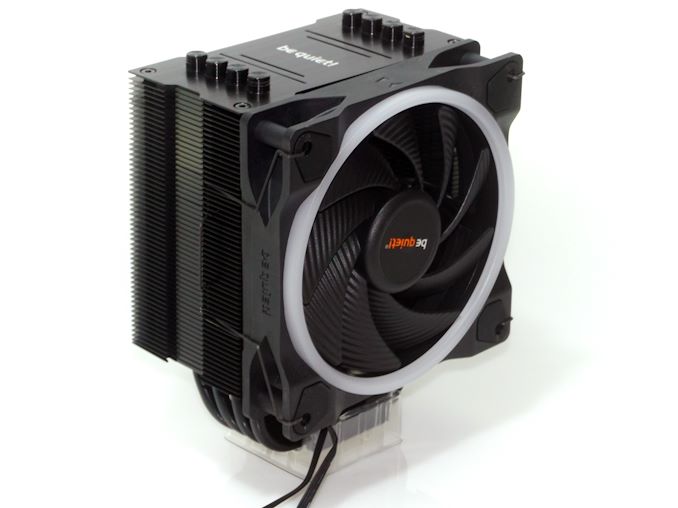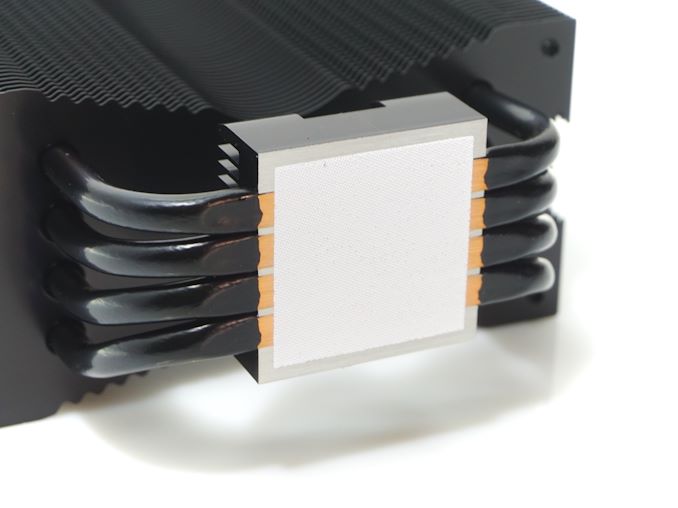The Be Quiet! Pure Rock 2 FX CPU Cooler Review: For Quiet Contemplation
by E. Fylladitakis on August 8, 2023 8:00 AM EST- Posted in
- Cases/Cooling/PSUs
- be quiet!
- CPU cooler
- ARGB
Conclusion
Be Quiet! developed the Pure Rock 2 FX to compete in the mainstream cooler market, building a cooler to serve a good all-rounder with emphasis on quiet operation. Be Quiet was very successful with the technical aspects of this, but actually delivering such a cooler at mainstream prices has proven a bit harder. In practice the cooler's retail price of $53 ends up putting it in competition against some of the more advanced offerings of the most reputable manufacturers on the globe.
The Pure Rock 2 FX CPU cooler from Be Quiet! impresses with its exceptional build quality and striking appearance. With its exceptional build quality and aesthetically pleasing appearance, it certainly makes a strong first impression. The attention to detail and craftsmanship are evident, making it a durable and long-lasting cooling solution. No significant flaws or weak points can be found upon close inspection, and its mechanical strength ensures it will withstand multiple installations and removals without damage. Be Quiet! has certainly set a high standard in this regard.
In terms of design, the Pure Rock 2 FX is a well-conceived product for the target market it is aiming at. By being not too large, heavy, or complex, it allures users who desire an uncomplicated experience and ensured compatibility. It also is cleverly designed so as to leave the RAM slots unhindered, allowing easy access and safeguarding that the cooler can still be used with a full set of RAM modules regardless of their height.
When it comes to raw cooling performance, the Pure Rock 2 FX performs above average but still cannot reach that of the highest-end coolers of comparable size. However, the Pure Rock 2 FX compensates for this with its outstanding acoustic performance. Operating quietly even under heavy load, it ensures a peaceful computing experience, making it an excellent choice for users who prioritize a silent environment.
One aspect where the Pure Rock 2 FX falls slightly short is its price point, as it sits on the slightly expensive side of the spectrum. This is always an area where we as reviewers risk splitting hairs over what amounts to five or ten dollars, but the mainstream market has no shortage of alternatives – or of cost conscientious consumers. To that end, while the higher cost of the Pure Rock 2 FX can be justified by its quality and performance, it will definitely give budget-minded consumers pause. Nonetheless, for those willing to invest a little extra in a premium CPU cooler, the Pure Rock 2 FX offers a compelling all-around package that delivers on its promises.
In summary, the Pure Rock 2 FX CPU cooler from Be Quiet! is an excellent choice for users seeking a reliable, high-quality cooling solution for their PCs. As an all-rounder, the Pure Rock 2 FX impresses with its balance of features. It may not be the absolute best in cooling performance, but its combination of superb build quality, silent operation, and robust thermal handling makes it suitable for a wide range of users. Despite the slightly high $53 price tag, the Pure Rock 2 FX's overall performance and capabilities make it a worthy investment for those in need of a high-quality CPU cooler. Whether you're an advanced user or an enthusiast, the Pure Rock 2 FX is sure to meet your cooling needs without disturbing your ears while adding a touch of elegance to your system.












32 Comments
View All Comments
meacupla - Wednesday, August 9, 2023 - link
Direct touch heatpipes have their downsides.The heatpipes need to make even contact over all the hot spots to be most effective. On Anandtech's test bench, this downside is unlikely to show up. This is more likely to happen on AMD chiplet CPUs, where the hot-spot is off-center.mode_13h - Friday, August 11, 2023 - link
If AMD had brought their vapor chamber IHS to market, that should virtually eliminate hotspots, making direct-touch heatpipes ideal. It'd be just like we see in high-end GPUs that integrate vapor chambers, and we all know how much heat those can dissipate!charlesg - Wednesday, August 9, 2023 - link
I have a Noctua on my 5950X. Very pleased with it.Their customer service is out of this world, too!
At one point I wanted to add more memory to my system, only to find out the pipes from the cooler were in the way. So I emailed them.
They sent me a new bracket that would allow me to have the pipes a different direction. From Germany. Complete with shipping notification in German. For free!!!
Samus - Thursday, August 10, 2023 - link
I've had my D15 since ~2015 and recently had to have them send me the bracket for socket 1700. They did so 2-day mail for free. I still have the original 120mm fans on it too. I cleaned them when I rebuilt the PC with the new board\CPU and they still work perfect. The D15 and my PCP&C power supply are the oldest components (my PSU is even older - from 2008) and they still work.Threska - Tuesday, August 8, 2023 - link
"Modern, high-end CPUs will essentially will turbo as hard and as long as their cooling systems will allow, making sustaining those clockspeeds critical to getting the best performance out of a system."Increase chances of a crash as well. Some being the silicon lottery.
mode_13h - Tuesday, August 8, 2023 - link
One benefit you supposedly get from buying Xeon CPUs is that they are qualified with extra margins, to ensure stability.Since I can no longer afford any of the Xeons or the platform they require, I will try to get by with running a mainstream Core-series CPU on a restricted power budget. And ECC RAM, of course.
Sivar - Wednesday, August 9, 2023 - link
You can always use an AMD CPU. In this generation, their CPUs use half the power. Intel is now playing the old AMD game of overclocking their own CPUs to ad absurdum just to keep up with their competitor.blzd - Friday, August 18, 2023 - link
DDR5 has built in ECC on consumer level I believe.tygrus - Monday, August 21, 2023 - link
Standard DDR5 has ECC on chip protecting from random 1bit per byte flips while data is at rest. It doesn't cover the signal integrity between CPU & RAM.Reg ECC DDR5 for servers provides the extra protection of data in transit in addition to protecting data at rest.
mode_13h - Thursday, August 24, 2023 - link
@tygrus, you mention "Reg ECC DDR5", but it's also available unbuffered.The main downside of ECC DDR5 DIMMs is that you now need 25% more DRAM chips than non-ECC, due to the bifurcation of the DIMMs into 2 32-bit subchannels, yet each still having 8 bits of ECC.